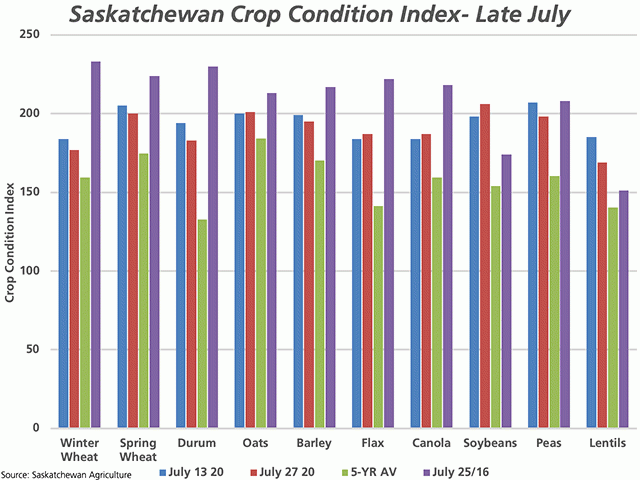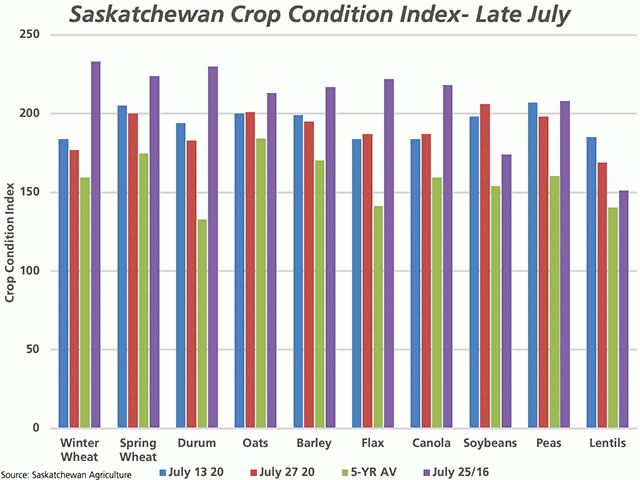Canada Markets
Saskatchewan Crop Condition as of End of July
According to the Saskatchewan government's weekly Crop Report as of the week ended July 27, crop conditions remain favorable despite facing hot temperatures seen over the week and drier conditions faced in the province.
While the government describes the overall crop in fair-to-good condition, they also state that "most of the spring cereals, canola, field peas and soybeans are in fair-to-excellent condition," which includes the province's largest crops.
Over the past two weeks, the crop condition index has fallen slightly for winter wheat (177), spring wheat (200), durum (183), barley (195) and peas (198), falling a modest 4 to 11 points, along with a slightly larger drop of 16 points for lentils (169), with the CCI shown in brackets.
The CCI for oats (201), flax (187), canola (187) and soybeans (206) showed an improvement of 1 to 8 points over the week, with the CCI shown in brackets. Looking across the major crops shown, the CCI ranges from 9.1% to 37.8% higher than the 5-year average for the end of July, with the CCI for durum, flax and soybeans more than 30 points higher than average. Spring wheat is 14.4% higher than average, while canola is 17.3% higher than average, which is represented by the green bars on the chart.
P[L1] D[0x0] M[300x250] OOP[F] ADUNIT[] T[]
For almost all of the crops shown on the chart, the CCI calculated for the end of July in 2020 is the highest seen since 2016, which are represented by the purple bars in the attached chart. Exceptions are seen for both soybeans and lentils, with the CCI calculated in the current year higher than any year in the past five years. At the same time, the CCI calculated for lentils of 169 is just 3 points higher than reported for this week in 2019.
While the crop is far from being in the bin, we will look at historic yields for select crops. According to Statistics Canada, Saskatchewan's spring wheat yield has averaged 45.5 bushels per acre (bpa) over the past five years (2015-2019), while the 2016 yield is reported at 46.1 bpa. The current CCI points to the potential for a yield in this range.
Over the past five years, the durum yield has averaged 38.6 bpa, while the 2016 yield was well above this level at 48.5 bpa. It is interesting to note that the current CCI is 50 points above the 5-year average, while 47 points below the index of 230 reported for this week in 2016. Yield potential may exist near the middle of this range.
Over the past five years, the province's canola yield has averaged 39.5 bpa, while the 2016 average is reported at 42.1 bpa. Once again, the current CCI could suggest a 2020 yield in this range.
DTN 360 Poll
This week's poll looks at the readers' comfort level with the various crop condition assessments released by government for their particular area. You can weigh in with your thoughts in this poll which is found at the lower right of your DTN Home Page.
Cliff Jamieson can be reached at cliff.jamieson@dtn.com
Follow Cliff Jamieson on Twitter @Cliff Jamieson
© (c) Copyright 2020 DTN, LLC. All rights reserved.






Comments
To comment, please Log In or Join our Community .